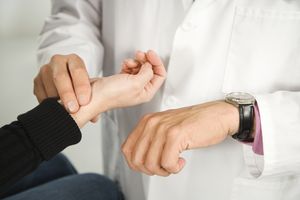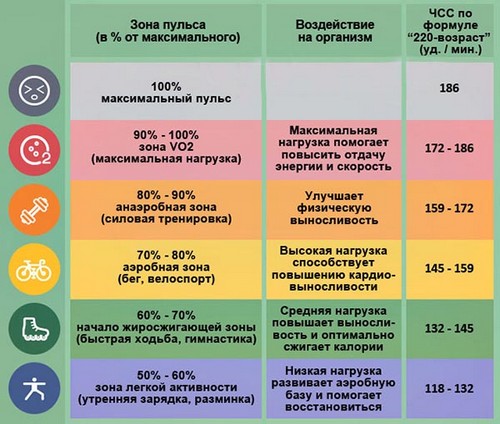Cardiologists and sports medicine professionals recommend to focus on the rate of pulse measured during physical activity. Usually, if the heart rate during exercise higher than normal, the loads are considered excessive, and if not up to standards is insufficient. But there are physiological characteristics of an organism affecting the heart rate.
A well-known saying “movement is life” concluded the main principle healthy life body.
The benefits of physical activity the cardiovascular system is not in doubt, neither the doctors nor the athletes or ordinary people. But how to determine their own rate of intensity of physical activity, not to cause harm to the heart and the body in General?
Why heart rate increases?
All organs and tissues of a living organism in need of saturation with nutrients and oxygen. This requirement keeps the cardiovascular system – download heart blood nourishes the organs with oxygen, and returns to the lungs, where gas exchange occurs. At rest, this occurs at heart rate from 50 (trained people) to 80-90 beats per minute.
When moving the need for all organs of oxygen increases dramatically. That’s why pulse rate increases after exercise.

The heart receives a signal about the necessity of getting a greater portion of oxygen and begins to work at an accelerated pace, to ensure the flow of required volume of oxygen.

To find out whether the heart works and is adequate if the load gets, you must consider the normal pulse rate after different physical activities.
Normal values may vary depending on the physical fitness and age of a person, so to define the formula maximum heart rate: 220 minus the number of full years of so-called formula Haskala-Fox. From the received values and to calculate the rate is the heart rate for different types of loads, or training zones.
When walking
Walking is one of the physiological States of the person, walk on the spot decided to start my morning calisthenics as a warm-up. For this training zones – when walking – there is a norm of pulse, equal to 50-60% of the maximum value.
Let us calculate for example the normal heart rate for 30-year-old man:
- Determine the maximum value of heart rate according to the formula: 220 – 30 = 190 (beats/min).
- Find out how many beats are 50% of maximum: 190 x 0.5 = 95.
- In the same way – 60% of maximum: 190 x 0.6 = 114 beats.
Get the normal heart rate when walking for 30-year-old in the range of 95 to 114 beats per minute.
With the cardio
Especially popular among middle-aged people use classes cardio, or cardio that is workout for the heart. The objective of these trainings is to strengthen and slightly increase the heart muscle, thereby to increase the volume of cardiac output. The heart will learn to work slower, but much more effective. The rate of heart rate during cardio is calculated as 60-70% of the maximum value.
Example of calculation of heart rate for cardiovascular 40-year-old man:
- The maximum value is: 220 – 40 = 180.
- Valid 70%: 180 x 0.7 = 126.
- Valid 80%: 180 x 0.8 = 144.
The obtained normal range of heart rate during cardio for 40-year-olds – from 126 to 144 beats per minute.
When running
Perfectly strengthens the heart muscle and slow Jogging.

The normal heart rate in this training zone is calculated as 70-80% of maximum heart rate:
- Maximum heart rate: 220 – 20 = 200 (for 20 years).
- Optimally valid when running: 200 x 0.7 = 140.
- The maximum allowed when running: 200 x 0.8 = 160.
In the end, the normal heart rate when running for 20 years will be from 140 to 160 beats per minute.
For fat burning
There is such a thing as a fat burning zone (SSZ), which is a load at which there is maximum burning of body fat – up to 85% of the calories. It may seem strange, it occurs during training, the appropriate intensity cardio. The reason is that at higher loads, the body has no time to oxidize fat, so the source of energy is muscle glycogen and burned body fat and muscle mass. The main rule for SSI – regularity.
Athletes
For people who are professionally involved in sports, an ideal rule heart rate does not exist. But the athletes – the highest level of norm of heart rate during exercise. They have a normal heart rate during intense exercise is calculated as 80-90% of maximum. And during the peak of the pulse of an athlete may be 90-100% of maximum.
The type and intensity of physical activity are of great importance. For example, runners who train for endurance, heart rate under load is lower than that of the athletes of the security forces.
You should also consider the physiological condition involved in sports (the degree of morphological changes of the myocardium, the weight of the body) and that alone palpitations athletes is much lower than in untrained people. Therefore, the calculated values can vary from actual by 5-10%. Sports physicians consider more indicative of the level of heart rate before the next workout.
For more accurate calculations, there are complicated calculation formula. They are indexed not only under age, but also the individual heart rate at rest and the percentage of the intensity of the exercise (in this case 80-90%). But these calculations represent a more complex system, and the result is not too different from the used above.

The heart rate during exercise is influenced by such factors as age.
Maximum heart rate by age
Here are age-related changes in heart rate in the table.
| Age group | The maximum heart rate, beats/minute |
|---|---|
| Up to 25 years | 195 |
| Up to 30 | 190 |
| Up to 40 | 180 |
| Up to 50 | 170 |
| Up to 60 | 160 |
Thus, the maximum heart rate during exercise, depending on age ranges from 159 to 200 beats per minute.
Post-workout recovery
As already mentioned, in sports medicine, attention is paid to the pulse should be not only during, but also after a workout, especially the next day.
- If before the next workout your resting heart rate is 48 to 60 beats, which is considered an excellent indicator.
- 60 to 74 – a good indicator of fitness.
- Up to 89 beats per minute is considered satisfactory pulse.
- Above 90 is an unsatisfactory indicator training to start undesirable.
And how long should recovery heart rate after exercise?
How long normal is recovered?
On recovery heart rate after exercise in different people takes different time – from 5 to 30 minutes. Normal is 10-15-minute break, after which the heart rate recovers to the initial (before training) values.

In this case, also important is the intensity, its duration.
For example, athletes, security forces are given 2 minutes break between sets to the rod.
During this time the pulse should be reduced to 100 or even 110 beats per minute.
If this happens, doctors recommend to reduce the load or the number of sets, or increase the intervals between them.
After the cardio heart rate should recover in 10-15 minutes.
Talking about long-term preservation of high heart rate?
If after exercise the heart rate a long time (over 30 minutes) remains high, should undergo a cardiological examination.
- For the novice athlete for a long maintaining a high heart rate says about the lack of heart to intense physical stress, as well as about the excessive intensity of the loads themselves.
- Increasing physical activity should be gradual and always with the control of heart rate during and after class. You can buy a heart rate monitor.
- The heart rate control must comply with and trained athletes – not to give the body to work hard.
Regulation of heart rate is accomplished by neurohumoral. It have the effect of epinephrine, norepinephrine, cortisol. For its part, the sympathetic and parasympathetic nervous system competitive excites or inhibits the sinus node.
Causes of prolonged palpitations a lot, including the factors of a pathological nature, and deal with them one needs a specialist.
Conclusion
- Normal heart rate during exercise can be called a value ranging from 120 to 160 beats per minute.
- Maximum heart rate is calculated by the formula 220 minus the full number of years.
- Pulse during cardio should not exceed 60-70% of maximum. When such a pulse occurs in the most efficient fat burning.
- Recovery heart rate after active loads should occur within 10-15 minutes of rest.



